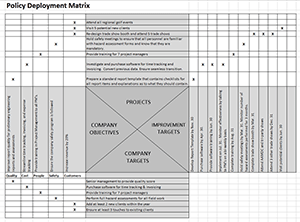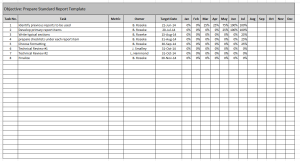
Many brilliant strategies fail. It doesn’t take long to think of names like J.C. Penney, Blackberry, and Kodak. The policies developed by the management team sounded good, but sometimes they just don’t translate into results. Policy deployment is the implementation of a corporate strategy, which probably plays at least some role in most corporate failures.
Therefore, policy deployment is defined as the translation of corporate strategy into action. Workers cannot implement a strategy they:
- do not know.
- do not understand.
- are not committed to.
In most companies, these are quite common place.
Policy deployment is a component of Total Quality Management and a foundational building block of Lean, Six Sigma, and other project quality systems.
 The central planning tool involved in policy deployment is called a policy deployment matrix. To develop the matrix, the following 5 step process is carried out:
The central planning tool involved in policy deployment is called a policy deployment matrix. To develop the matrix, the following 5 step process is carried out:
- Develop Corporate Objectives (if not already developed).
- Develop Corporate Targets.
- Select Projects.
- Determine Improvement Targets.
- Create the Implementation Plan.
Corporate Objectives
Often this is clearly established before you get to the deployment stage. Often more than one is present, and all should be itemized in the matrix. Corporate objectives should be SMART:
- Specific. What will the goal accomplish?
- Measurable. How will you measure whether or not the goal has been reached?
- Achievable. Is it possible to achieve?
- Results focused. What is the benefit in accomplishing the objective?
- Time bound. What is the completion date?
All of these questions need to be answered before the implementation of the strategy is addressed.
I’ve found that the best way to effectively implement corporate strategy is to determine at least 5 of these corporate objectives, and make sure they are specific. Almost all corporate strategy includes things like increasing share price, maximizing revenue, and the like. That’s the easy way out, and it usually results in strategy sessions becoming a paper pushing exercise that has no meaningful results on the ground. For the purposes of policy deployment, objectives are better more specific, such as “reduce defects” or “improve review processes.”
Corporate Targets
Once you determine what the objectives are, targets for each should be established. For example, if the objective is “reduce defects” a target might be “5 defects per 10,000 items shipped, as measured by customer complaints.”
The objective does not have to contain numbers, but the target should.
Select Projects
Once the targets have been chosen, improvement projects can be initiated. Available resources such as project managers and team members should be considered, and budgets need to be in place.
From my experience, by this point the projects required to carry out the corporate strategy tend to be obvious. For example, if a corporate objective is to “reduce defects” a Six Sigma project could be identified. Most managers know what needs to be done to improve their unit, and at the risk of sounding like I’m belittling the process (not my intention), sometimes strategy becomes a way to tell them politely that it’s time to do it.
Improvement Targets
These are targets that are linked to the above projects. For example, if a Six Sigma project is identified then a realistic improvement target might be to “reduce defects to 5 in 10,000.” It should be specific and measurable, just like the SMART objectives listed above. Throughout the strategy deployment program, these improvement targets will be scrutinized and their progress evaluated. These form the backbone of the program, because they can be measured down the road to determine the effectiveness of the strategy deployment.
 Create the Implementation Plan
Create the Implementation Plan
Once the improvement projects and targets are established, the implementation plan identifies who is responsible for which target, and provides a means for judging the percent complete of each task. The implementation plan is the ongoing progress chart used by the project team to ensure the targets are met.
Policy Deployment Matrix
As mentioned above, the deployment matrix is essentially the cornerstone product of the policy deployment stage. You will find other spreadsheets and tables relating to policy deployment, but they will all derive from the matrix in one form or another.
The first four steps listed above are the four pillars of the matrix, and the last step is the implementation of the plan.
To use the matrix, you start with the left hand column, proceed to the bottom, then the top, and finally, the right hand side. This is the order in which the 5 steps in this article have been set up.
Policy Deployment Matrix Example
Here is our example, in MS Excel format: Policy Deployment Matrix. You are free to change the data in it, use it for yourself and distribute it free of charge.





Leave a Reply